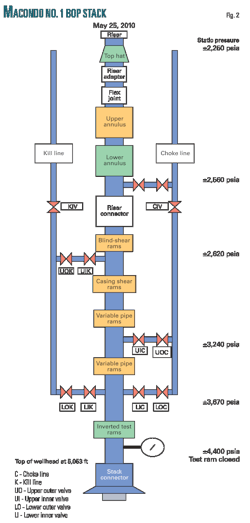Various agencies have started releasing documents showing the downhole completion and design considerations for the Macondo No. 1 well on Mississippi Canyon Block 252 in the Gulf of Mexico that blew out on Apr. 20 during operations for temporarily abandoning the well.
BP Exploration & Production Inc. is the operator of well and acquired the MC252 Block in a 2008 lease sale for a bonus payment of $34 million. The lease has a 183⁄4% royalty rate.
BP retained a 65% interest in the lease and its partners of record are Anadarko E&P Co. LP 22.5%, Anadarko Petroleum Corp. 2.5%, and Mitsui Oil Exploration Co. Ltd. unit Moex Offshore 2007 LLC 10%.
BP estimated that the well would cost about $96 million and take 51 days to drill.
The Transocean Marianas, a Sedco 700 design semisubmersible drilling rig, spud the well on Oct. 7, 2009. Hurricane Ida damaged the rig on Nov. 8-9 and Transocean towed the rig to a shipyard for repair on Nov. 26.
The Marianas was replaced on the Macondo 1 well with the Deepwater Horizon, a Reading & Bates Falcon RBS8D design semisubmersible drilling rig, capable of operating in 8,000 ft of water that was built in 2001. Deepwater Horizon landed the blowout preventer (BOP) stack on the well on Feb. 8. The water depth at the site is 4,992 ft.
Well completion
Several well-control events occurred during the drilling of the well. A Transocean timeline, dated June 8, indicates that these events occurred during Feb. 17-23, Mar. 2-5, Mar. 8-14, and Apr. 4-7. The timeline notes that all events were successfully controlled.
During the Mar. 8-14 well control event, a Schlumberger tool used in an attempt to retrieve stuck pipe became lodged and was abandoned in the well.
Because of the various well-control events, the well has more pipe strings then initially envisioned. The pipe includes a 36-in. conductor; 28-in. and 22-in. casing strings; an 18-in. liner; a 16-in. casing string; 135⁄8-in., 117⁄8-in., and 97⁄8-in. liners, and 7 by 97⁄8-in. production casing (Fig. 1).
Below the 22-in. casing, the drilling mud used was a synthetic oil-based mud (internal olefin, ester) with a weight that ranged from 10.1 to 14 ppg.
Fig. 2 shows the arrangement of the BOP stack and lower marine riser package (LMRP) with estimated pressures prior to an unsuccessful "top kill" operation in late May.
The BOP stack includes two Cameron Type TL 18¾-in., 15,000 psi double preventers, one Cameron Type TL 18¾-in., 15,000 psi single preventer, one Cameron DWHC 18¾-in., 15,000 psi wellhead connector.
The LMRP has two Cameron DL 18¾-in., 10,000 psi annular preventers, and one Cameron HC 18¾-in., 10,000 psi connector.
The rig also came equipped with a Hydril 60 diverter with a 21¼-maximum bore and 500 psi working pressure, as well as two 18-in. flowline outlets.
Used to control the BOPs, was a Cameron Multiplex control system.
A Vetco HMF-Classs H, 21 in. OD, with choke and kill and booster and hydraulic supply lines was installed on the well.
Blowout investigation
Various investigations continue on what caused the well to blow out.
As noted in a June 14 letter from the House of Representatives Committee on Energy and Commerce to BP, several changes in the design might have lessened the chance of a blowout.
One point raised in the letter was that setting a liner on bottom and tying it back to surface with a casing string could have provided an additional barrier to prevent gas from flowing up the annulus. The 7 by 97⁄8-in. production string as run created an open annulus to the wellhead and made the seal assembly the only barrier to gas flow in case the cement across the producing formation failed.
Transocean in its preliminary investigation report said that the cement job on the production string included 60 bbl of 16.7 ppg cement with nitrogen for reducing the weight of the cement.
Another point made in the letter was that running 21 centralizers instead of 6 would have improved the cement job. With 6 centralizers, Halliburton's analysis was that the well could encounter severe gas flow problems. Also the running of a cement bond log might have verified the condition of the cement.
The letter also noted that BP only circulated 261 bbl of mud, a small fraction of the mud in the well, prior to cementing. The recommended API procedure is to circulate at least 1.5 annular volumes or one casing volume, whichever is greater, the letter noted. The circulation is for the removal of any gas or debris trapped in the mud.
A final point made in the letter is that BP did not install a lockdown sleeve on the seal assembly for the production string. Not having a lockdown could allow the casing to move up and break the seal, allowing fluid to enter the riser and reach the drilling rig.
More Oil & Gas Journal Current Issue Articles
More Oil & Gas Journal Archives Issue Articles
View Oil and Gas Articles on PennEnergy.com



